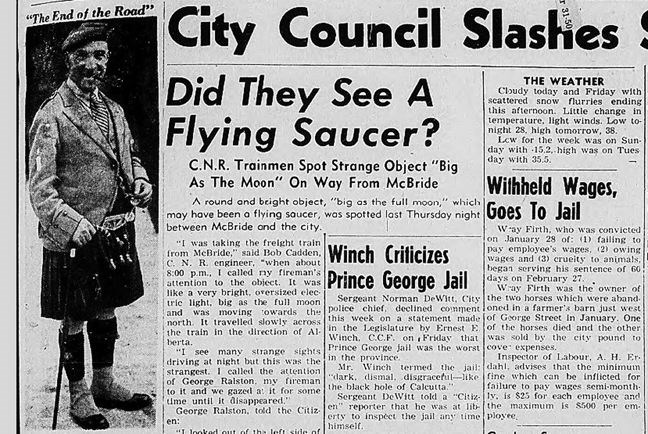This week in Prince George history:
March 16, 1950: The Prince George Citizen was looking for witnesses who may have seen a possible flying saucer between Prince George and McBride the previous week.
CN Rail engineer Bob Cadden told The Citizen: "I was taking the freight train from McBride when about 8 p.m. I called my fireman's attention to the object. It was like a very bright, oversized electric light, big as the full moon and was moving towards the north. It travelled slowly across the train in the direction of Alberta.
"I see many strange sights driving at night but this was the strangest," Cadden added.
George Ralston, the train fireman, confirmed Cadden's story.
"I looked out the left of the cab and saw the bright object. It looked to me like a ball of fire... I immediately though of flying saucers, but I did not have time to do much watching."
Citizen correspondents along the rail line didn't report seeing any strange objects in the sky, but the editor called for anyone who had also seen the object to contact The Citizen.
That offer is still good. If you saw a strange object in the sky between Prince George and McBride on March 9, 1950 sometime around 8 p.m. we'd love to hear the story. Call The Citizen at 250-562-2441.
March 17, 1922: "Birth control is being advocated as a preventative for war upon the ground that the basic cause for war has always been the necessity of providing room for increasing population," The Citizen reported.
American birth control advocate Margaret Sanger was in Japan to lecture on the "new fad" of birth control, despite opposition of Japanese authorities, the paper reported.
"In the minds of many Japan is looked to as the next nation of disturb the peace of the world to make room for its teeming millions, but Japan will not accept birth control as its way out," The Citizen report said.
Well, they got one part right at any rate. Imperial Japan's militaristic, expansionist policies would eventually provoke the Pacific theatre action of the Second World War. But birth control, sadly, hasn't lived up to the promise of ending wars.
March 14, 1935: Inspector Van Dyk received word that provincial constable J.S. Clarke had departed on a 300-mile trip by dog sled from Fort Nelson to Beaver River, near the Yukon border, to investigate the death of trapper Ben Olson, The Citizen reported.
In his dispatch to Van Dyk, dated Feb. 2, 1935, Clarke said under favourable conditions it would take him 15 days to reach Beaver River by dogsled and another 15 days to return. Clarke was sole law enforcement officer in Fort Nelson, serving as game warden, magistrate and coroner in addition to being the provincial constable.
According to Clarke's dispatch, another trapper named Burke had stopped by to visit Olson at his cabin and found his body on the floor with a .30-30 rifle lying beside him. Seeing no footprints leading to the cabin, Burke concluded that Olson had killed himself and carefully closed the cabin door and headed to the nearest Hudson Bay post to report the death.
Van Dyk didn't expect to receive word from Clarke about his investigation for another month. Clarke, a former RCMP officer, had previously lived in Vancouver.
I had to triple check that the date on this story was 1935 and not 1835. It's hard to imagine a time when the only cop, judge and game warden in town could take off for more than a month by dogsled to investigate a death 300 miles away.
March 14, 1940: The Prince George Hospital purchased its first X-ray machine, The Citizen reported.
"No longer will it be necessary for patients in the central interior of British Columbia suffering from illnesses requiring diagnostic X-ray services to go to Vancouver or Edmonton for those services as has unfortunately been the case heretofore," The Citizen reported. "The unit is one of the most modern machines in use in the world today..."
The Prince George Hospital Society authorized the $3,000 purchase of the machine at it's annual general meeting the previous week and installation was expected to happen in a few weeks time.
Hospital society secretary C.H. Wisenden reported the hospital served 933 patients in 1939, up from 860 patients the year before.
The total fees collected by the hospital in 1939 were $13,547.88, Wisenden reported. In addition the hospital received $8,380.50 in provincial grants (of which $7,839 was written off to cover the costs of "provincial indigents" and a further $4,195.65 for "municipal indigents") and $1,724.20 from the City of Prince George.
I'm sure this story was a real ray of sunshine for area residents. Although if they did need a X-ray, they'd be charged for the privilege. The first universal healthcare program wouldn't be introduced in Canada until 1946 in Saskatchewan, and the Canadian healthcare system as we know it today really began with federal Medical Care Act of 1966.



